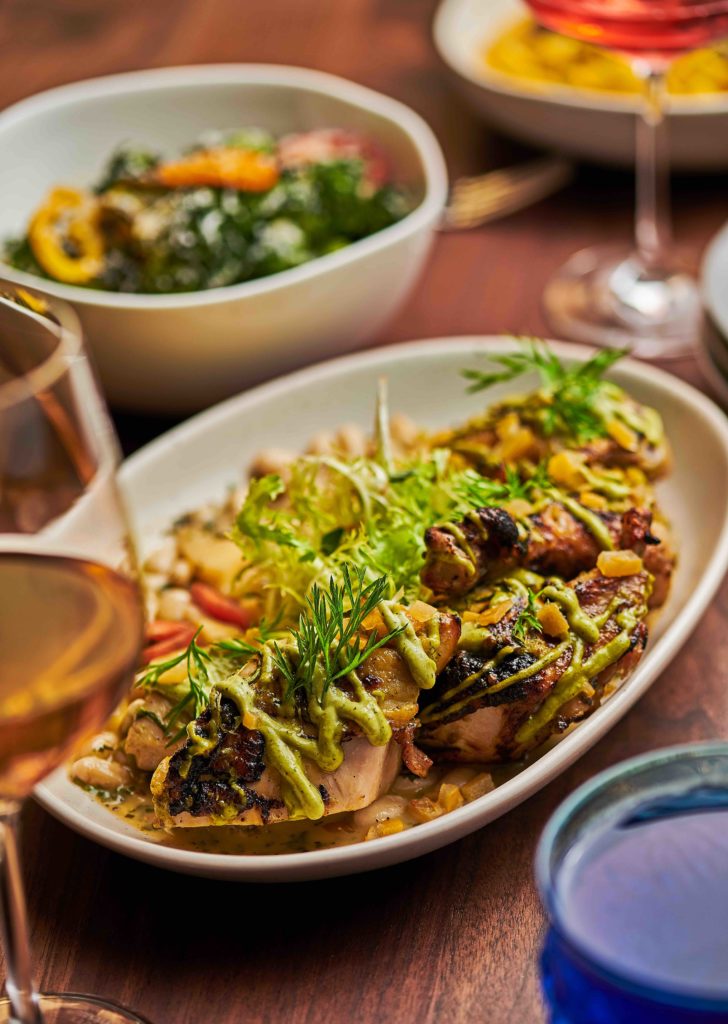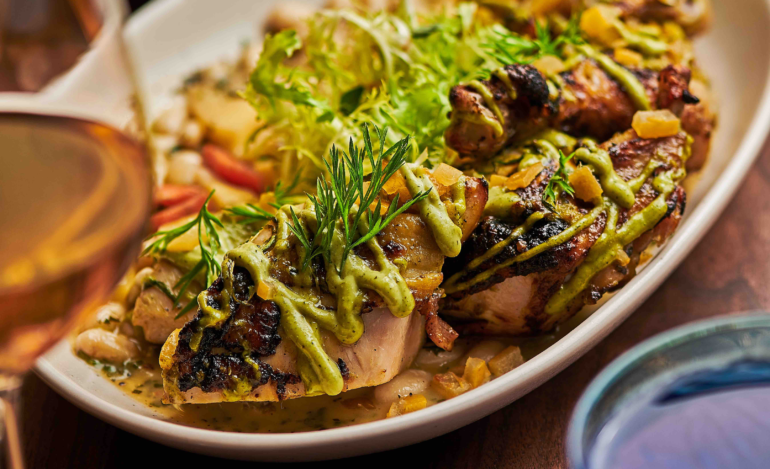A key ingredient in the recipe for a happy family is time spent around the dinner table. To help your family prioritize family meals, we’re bringing you Better Family Dinners — a series of stories and recipes shared by chefs, cookbook authors, members of the community, and their families to help you have Better Family Dinners together.
This recipe comes from Executive Chef Andrew Graves of LIVA at Chicago Winery. Born in Green Bay, Wisconsin, Chef Graves uses his Midwest roots as inspiration for his menus and he is passionate about sourcing ingredients from regional products, purveyors and farms. As part of our Better Family Dinners series, we asked Chef Graves to share some of his memories of food and family and to pass along a recipe for you to make for your own family — Goddess Chicken with White Bean Cassoulet.
What was your family dinner routine growing up?
The dinner routine in my family was fairly important when I was growing up. For the majority of my childhood my parents were shift workers so the times that my brother, sister, parents and I got to sit around a table and eat were not scarce but not regular either. My father was the cook in the family and when he had the time at home he would enjoy preparing the recipes my grandmother showed him growing up. They were usually very classic Northern Midwest meals centered around a hearty protein like roasted chicken or beef chuck pot roast. They would usually come accompanied with various forms of potatoes like mashed with gravy or baked with butter and boiled vegetables such as corn, peas or carrots with a hint of an herb like dill. That is unless it was summer, then my Dad would be grilling anything from beer brats to steaks or pork chops. The meals were never anything extravagant but always properly prepared and seasoned, so throughout my childhood, I never had problems getting friends to stay for dinner. Being the jovial “Sconnies” we have always been, we were happy to share our dinnertime antics. Then, of course, there were Sunday dinners at my Grandparents house with the extended family when my Grandma would put out a spread that would rival any Grandma’s short of Julia Child.
Do you have a fond memory that centers around food?
I have many memories centering around food, some fond and some otherwise but they all have served to shape me into the chef I am today. I’m still not sure if I was fortunate to have so many vivid memories around food or if it’s that, as a chef, I’ve mined the caverns of my memory to highlight those moments because they are so vital to my development.
I can remember a distinct one from a vacation we took as a family to Los Angeles to visit my aunt’s family. We stayed with them for a few days but ended up cramming into a rental car and traveling almost seven hours up Highway 1 to San Francisco. The whole time, 10-year-old me was confused as to why we were driving the better part of a day (through car sickness and my dad’s soliloquies on San Fran sourdough and chowder) just for some bread and soup. It wasn’t until my dad handed me a slice of real San Francisco sourdough bread that I even knew there was such a thing as bread with flavor.
Do you have any traditions that you have carried on?
Since starting a family of my own I have made it a point to continue the traditions I was raised on. My wife, son, daughter and I take every chance possible to gather around a table to enjoy a home-cooked meal. Having developed as a chef I’ve ventured into other things than roasted chicken and pot roast but both my family and I understand and enjoy the importance of passing along the traditions that shaped us and our family into what it is today.
What memories and lessons have you taken away from your own family dinners?
I come from as typical of an Upper Midwestern family as you can imagine. As the proud son of a mill worker and maternity nurse much of the discussion around the dinner table was centered around doing things the right way and harnessing the gifts bestowed on oneself to help others. I’ve used those lessons and many others (with a healthy dose of a good sense of humor) to sustain myself as a young cook through strenuous times in some of the best kitchens in the U.S. Now I revel in spreading those “fatherly words of wisdom” to my children around the table and to the next generation of chefs along the kitchen pass.

Recipe: Goddess Chicken with White Bean Cassoulet
Here’s how to make Chef Graves’ simple yet show-stopping Goddess Chicken, a dish that plays up the trendy green dressing and brings color to a winter table.
Serves four
For the Green Goddess
- 2 cups mayo
- 1 cup sour cream
- 1/2 avocado
- 4 Tablespoon lemon juice
- 2 bunch scallion, chopped
- 1 clove garlic, chopped
- 3 Tablespoons chives, chopped
- 1 Tablespoon Tarragon, chopped
- 1 Tablespoon Dill, chopped
- 1 Tablespoon Parsley, chopped
Combine the mayo, sour cream, avocado, and lemon juice in a food processor or blender until smooth. When smooth pulse in the chopped garlic chives tarragon dill and parsley. Season with kosher salt to your liking. This recipe makes more than you will ever need for this dish but it holds well in the fridge and who doesn’t like the green ranch on just about anything.
For the Chicken
- 1 3lb chicken
- 1 medium spanish onion
- 1 medium carrots, peeled and cut into thumbnail sized pieces
- 1 medium parsnip, peeled and cut into thumbnail sized pieces
- 1 smaller rutabaga, peeled and cut into thumbnail sized pieces
- 1 cup white wine
- 1 cup chicken stock
- 1 can cannellini beans
- 4T fines herbs: parsley, chive, tarragon, dill; all chopped
- 1bu kale, stemmed and torn
- 1 stick butter
- 1T preserved lemon chopped small
Split the chicken into 8 separate pieces: two drumsticks, two thighs, and both breasts cut in half. If you don’t feel confident in your butchery work, feel free to ask your local butcher for a fresh chicken cut “8 way”. If the chicken is wet, dry it by dabbing it with a paper towel to avoid splattering with the initial cook. Season the chicken liberally with kosher salt and pepper. In a 12″ skillet brown the chicken pieces in oil and set them aside. Drain off the excess oil and add the diced onion, carrot, parsnip, and rutabaga. Cook over medium-low heat until the onions are soft and translucent. Add the wine and cook it down by half way. Add the chicken stock, beans and reserved chicken. Bring the cassoulet to a simmer and cook for about 20 min or until the chicken is cooked through. I like to check for doneness by piercing a piece of the dark meat, if the juice comes out clear it is ready to eat. Once cooked, take it off the heat and add the fine herbs, kale, and stir in the butter until it’s melted and the kale is wilted. Check the seasoning and garnish with the green goddess dressing and preserved meyer lemon that has been chopped small. I like to serve this dish with a simple salad of frisee, fine herbs, and red onion dressed with something like italian vinaigrette or more of the green goddess dressing.
I prefer to use fresh cannellini beans that have been soaked overnight and cooked with onion sage and white peppercorn until soft but canned beans are a perfectly acceptable substitute if you are constrained for time. I also like to brine my chicken for at least 4 hours in a solution of 1qt water, 2 tablespoons of salt, and 2 tablespoons of sugar if time allows. It’s a six week process to make your own preserved Meyer lemons so I would suggest buying some either at a specialty store or online. I love to garnish just about anything with the chopped rind. It always adds an intense explosion of salty-lemony brightness to a dish.
Get more Better Family Dinner recipes and stories
How to Help:
The Family Dinner Project is a nonprofit that champions family dinner as a way for families to connect through food, fun and conversation about things that matter. Based in Boston at Massachusetts General Hospital’s Psychiatry Academy, the Family Dinner Project team works with national and community organizations online and at community events to help families increase the frequency, meaning and long-term benefits of their shared meals. Learn more about their resources and partnership opportunities and donate to support their important work.


